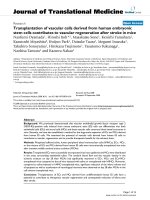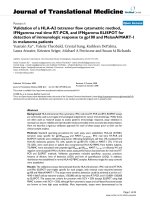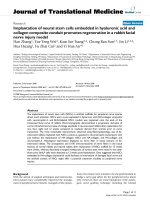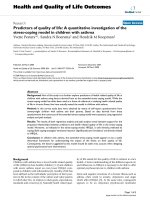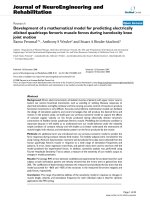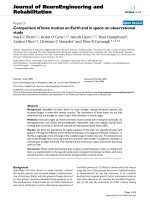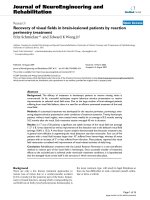Báo cáo hóa học: " Investigation of pre-structured GaAs surfaces for subsequent site-selective InAs quantum dot growth" potx
Bạn đang xem bản rút gọn của tài liệu. Xem và tải ngay bản đầy đủ của tài liệu tại đây (547.9 KB, 4 trang )
NANO EXPRESS Open Access
Investigation of pre-structured GaAs surfaces for
subsequent site-selective InAs quantum dot
growth
Mathieu Helfrich
1
, Roland Gröger
2
, Alexander Förste
2
, Dimitri Litvinov
3
, Dagmar Gerthsen
3
, Thomas Schimmel
1,2
,
Daniel M Schaadt
1*
Abstract
In this study, we investigated pre-structured (100) GaAs sample surfaces with respect to subsequent site-selective
quantum dot growth. Defects occurring in the GaAs buffer layer grown after pre-structuring are att ributed to
insufficient cleaning of the samples prior to regrowth. Successive cleaning steps were analyzed and optimized.
A UV-ozone cleaning is performed at the end of sample preparation in order to get rid of remaining organic
contamination.
Introduction
Quantum dots (QDs) are promising candidates for
quantum information devices such as quantum bits in
quantum computers or quantum memories. Self-
ass embled QDs were investigated in this context during
the past decade. They can produce single photons and
can be coupled to microcavity resonators [1,2]. How-
ever, for large-scale applications it is essential to transfer
the aforementioned schemes to well-positioned QDs in
order to obtain a defined device architecture. One
approach to site-selective QD growth utilizes substrate
pre-structuring [3,4]. Small holes are created on the sub-
strate surface in order to alter the surface chemical
potential which leads to an increased growth rate at the
hole sites. Thus, QDs preferentially nucleate at the
defined locations.
Various tools such as electron beam lithography (EBL)
or local oxidation are available to pre-structure
substrates [5,6]. In most cases the procedure of pre-
structuring involves several process steps including dif-
ferent chemicals which inf luence the substrate surface.
For subsequent QD growth, however, it is necessary to
provide a clean surface in order to minimize defects and
uncontrolled QD nucleation. It is assumed that defects
originating from the regrowth interface degrade the
optical quality of the QDs. Therefore, great ca re has to
be taken for surface cleaning after pre-structuring.
Inthisstudyweinvestigate the origin and effect of
possible surface contamination which occurs during sur-
face pre-structuring.
Experiment
The samples were grown by molecular beam epitaxy
(MBE) and pre-struct ured using conventional EBL.
A GaAs epitaxial layer is grown on epi-ready (100)
GaAs wafers foll owed by surface pre-structuring. During
EBL 50-70 nm large holes were defined in a poly(methyl
methacrylate)/(methacrylic acid) co-po lymer resist on
the surface. The holes are arranged on a square grid.
Several arrays with varying lattice constants were
defined that way. After development the holes were
etched down 30 nm by wet chemical etching (WCE)
using H
2
SO
4
:H
2
O
2
:H
2
Owithalowetchrateof1nm/s.
The resist was removed and the samples were cleaned
in a series of solvent baths and ultrasonic cl eaning . An
additional clean ing step w as introduced later on, which
uses ozone generated by ultraviolet light to remove resi-
dual organic contamination.
Before QD growth the samples were heated up to 130°
C for 1 h in the load lock chamb er of the MBE system
in order to get rid of volatile surface contamination.
Thesurfaceoxidewasremovedin situ by Ga-assisted
* Correspondence:
1
DFG-Center for Functional Nanostructures (CFN) and Institut für
Angewandte Physik, Karlsruhe Institute of Technology (KIT), 76131 Karlsruhe,
Germany
Full list of author information is available at the end of the article
Helfrich et al. Nanoscale Research Letters 2011, 6:211
/>© 2011 Schaadt et al; licensee Springer. T his is an Open Access artic le distributed under the terms of the Creative Commons
Attribution License (http://creativecommons.o rg/licenses/by/2.0), which permits unrestricted use, distribution, and reproduction in
any medium, provide d the original work is properly cited.
deoxidation [7]. A 16 nm GaAs buffer layer (BL) wa s
then grown at 500°C followed by 1.7 ML of InAs. The
growth rates for GaAs and InAs were determined as 0.3
and 0.07 ML/s, respectively.
The pre-structured samples as well as the uncapped
QD samples were characterized by atomic force micro-
scopy (AFM). Transmission electron microscopy (TEM)
was used in order to investigate the regrowth interface
of QDs capped with 80 nm of GaAs.
Results and discussion
Sample growth
Holes with diameters ranging from 50-70 nm are repro-
ducibly defined by EBL and WCE as described above.
Figure 1 depicts a pre-structured GaAs sample. The
holes are arranged on a square grid with a separation of
500 nm. The representati ve l inescan does not reveal the
full depth since the AFM tip is too large to completely
enter the hole. P reviou s calibration of the etch rate sug-
gests a hole depth of about 30 nm for this particular
sample.
After reintroducing the pre-structured sample into the
MBE chamber, the native oxide has to be remo ved prior
to regrowth. The Ga-assisted deoxidation is advanta-
geous as it is performed at moderate temperatures and
thus inhibits additional surface pitting. Since only Ga is
provided this gentle deoxidation method does not intro-
duce electronic defects at the surface. Also, any excess
Ga on the s urface will be incorporated in the subse-
quent G aAs BL. The surface is monitored by means of
in situ reflection high energy electron diffraction
(RHEED). Diffuse and faint main streaks of the 2 × 4
reconstruction evolve into a clear full 2 × 4 reconstruc-
tion pattern after deposition of about 8 ML of Ga. The
RHEED pattern of a pre-structured sample after oxide
removal is shown in Figure 2. InAs QDs are grown on
top of a 16 nm GaAs BL. Mainly double dot nucleation
is observed. One possible reason for that phenomenon
isachangeinholeshapeduringBLgrowthwiththe
hole developing into two separate holes with increasing
BL thickness [8]. A sampl e with site-selecti ve InAs QDs
isshowninFigure3.Theupper linescan of Figure 3b
clearly reveals the double dot feature. M oreover, some
defects are apparent in the AFM images as well.
Figure 3a shows larger areas of defects (white circles)
and Figure 3b contains smaller defect holes, as visua-
lized by the low er linescan. Their origin is further inves-
tigated in the following section.
Hole defects
The additional defect holes were not defined during EBL
and thus interfere with the attempt of dete rministic QD
positioning. The holes are less than 16 nm deep, which
corresponds to the BL thickness. That is suggested by
the linescan of Figure 3b. Therefore, the defect holes
seem to originate from the regrowth interface. Further
confirmation is given by TEM analysis of a capped sam-
ple. Figure 4 shows a TEM image of the profile of a
defect hole, which was found on a pre-structured sam-
ple. The different layers of the structure are visible. In
this case the defect hole develops from the pre-struc-
tured surface upward in the GaAs BL. A local change
on that surface inhibits the proper regrowth of GaAs.
InAs, however, then nucleates inside the hole, which is
finally covered by the final capping layer. The GaAs
sidewalls of the d efect hole exhibit a curved shape with
increasing thickness of the Ga As BL at larger distan ces
from the hole. This implies th at strain is accumulated at
the surface of the GaAs BL facing the site where nuclea-
tion of GaAs is hindered.
In gen eral, two factors can account for the occurrence
of the described defect holes. First, incomplete removal
of the native oxide could leave residual oxide com-
pounds on the surface which affect the proper GaAs
regrowth. Second, insufficient surface cleaning after the
lithography process could cause local organic contami-
nation of the sample which also impacts the GaAs
growth.
500 nm
[011]
Figure 1 AFM image of pre-structured GaAs (100) surface.
Figure 2 RHEED pattern of GaAs (100) surface after Ga-assisted
deoxidation and subsequent quick anneal under As
4
atmosphere. The usual 2 × 4 reconstruction is observed indicating
the successful removal of the native oxide.
Helfrich et al. Nanoscale Research Letters 2011, 6:211
/>Page 2 of 4
Incomplete deoxidation is rather unlikely since the
defect holes are not randomly distributed. Some local
areas are found with a high defect density whereas other
areas seem very clean. In addition, by controlling the
surface evolution during deoxidation using RHEED, it is
made sure that enough Ga is provided to completely
remove the native oxide. Furthermore, similar samples
prepared by conventional thermal deoxidation as well
contained comparable defects. That is why we focused
on possibility two by analyzing and optimizing the
cleaning procedure.
Cleaning samples after EBL comprises several steps.
First, the resist needs to be removed which is done with
an adequate remover. Thereafter, the sample is cleaned
with different solvents (trichlorethylene, acetone, isopro-
pyl alcohol, methanol), if possible in a heated ultrasonic
bath. Finally, the samples are rinsed in bi-distilled water.
The resist used for EBL contains organic compounds.
Especially the high tempera ture during dry-baking of
the resist results in a h igh stability of such compounds
against solvents. Critical steps of the cleaning procedure
are depicted in Figure 5. The sample in Figure 5a was
cleaned using steps one and two of the above procedure
but without ultrasonic bath. A lot of contamination is
observed from the AFM image (large particles appearing
white ). When the samples are cleaned in a heated ultra-
sonic bath, the amount of contamination is reduced.
Especially the amount of smaller particles has decreased,
as seen in Figure 5b. However, there are still larger
areas of residues remaining on the surface. In order to
get rid of these remaining contaminants a UV-ozone
cleaning step is introduced. It utilizes a low- pressure
mercury lamp th at emits radiation at the relevant wave-
lengths of 184.9 and 253.7 nm [9]. Molecular oxygen is
dissociated by the shorter wavelength with the atomic
oxygen subsequently forming ozone. Ozone is then
decomposed by the longer wavelength. Atomic oxygen
is thus constantly provided. In addition, the 253.7 nm
radiation excites organic molecules. These react with
the atomic oxygen and form simpler, volatile com-
pounds that desorb from the surface. The effect of
UV-ozone cleaning is displayed in Figure 5c where
essentially all contamination has disappeared. As a
result, the number of defect holes should be drastically
reduced resulting in a uniform and flat GaAs BL after
regrowth. Clean oxygen was fed throughout the cleaning
process. UV-ozone cleaning is a very gentle process
which does not bombard the surface with ions. The
cleaning efficiency is comparable to conventional plasma
ashing. However, the costs for appropriate UV-ozone
cleaners ar e much low er. In fact, such devices can easily
be self-built.
Conclusion
In conclusion we have investigated pre-structured GaAs
sample surfaces for subsequent site-selective InAs QD
growth. We have demonstrated the effect o f different
cleaning steps after EBL and introduced a U V-ozone
cleaning procedure to remove the remaining organic
(b)(a)
Figure 3 AFM images of site-selective InAs QDs grown on a pre-structured substrate. Besides good site-selectivity larger areas of defects
are apparent (white circles), (a). Magnified image with linescans of a double dot (top) and a defect hole (bottom), (b).
InAs
Patterned surfac
e
50 nm
GaAs
GaAs
GaAs
50 nm
Figure 4 TEM image of burried defect hole originating from
the regrowth interface.
Helfrich et al. Nanoscale Research Letters 2011, 6:211
/>Page 3 of 4
contamination prior to regrowth. Successful operation of
this method has been confirmed.
Abbreviations
AFM: atomic force microscopy; BL: buffer layer; EBL: electron beam
lithography; MBE: molecular beam epitaxy; QDs: quantum dots; RHEED:
reflection high energy electron diffraction; TEM: transmission electron
microscopy; WCE: wet chemical etching.
Acknowledgements
The Karlsruhe researchers acknowledge financial support from the Deutsche
Forschungs-gemeinschaft (DFG) and the State of Baden-Württemberg
through the DFG-Center for Functional Nanostructures (CFN) within
subproject A2.6. We thank our collaborators J. Henrdrickson, G. Khitrova, H.
Gibbs from the University of Arizona in Tucson, S. Linden from the University
of Bonn, M. Wegener from the Karlsruhe Institute of Technology (KIT) for
sample preparation. Furthermore, we would like to thank Heinrich Reimer
for his help with designing and building the UV-ozone cleaner.
Author details
1
DFG-Center for Functional Nanostructures (CFN) and Institut für
Angewandte Physik, Karlsruhe Institute of Technology (KIT), 76131 Karlsruhe,
Germany
2
Institute of Nanotechnology (INT) and Institut für Angewandte
Physik, Karlsruhe Institute of Technology (KIT), 76131 Karlsruhe, Germany
3
Laboratorium für Elektronenmikroskopie (LEM), Karlsruhe Institute of
Technology (KIT), 76131 Karlsruhe, Germany
Authors’ contributions
MH prepared most of the samples, carried out the experiments to improve
the sample surface quality, performed the AFM measurements and drafted
the manuscript. RG and AF gave their support with AFM measurements. DL
carried out the TEM analysis. DG, TS and DMS conceived of the study and
participated in its design and coordination. All authors read and approved
the final manuscript.
Competing interests
The authors declare that they have no competing interests.
Received: 13 Septem ber 2010 Accepted: 11 March 2011
Published: 11 March 2011
References
1. Michler P, Kiraz A, Becher C, Schoenfeld WV, Petroff PM, Zhang L, Hu E,
Imamoğlu A: A Quantum Dot Single-Photon Turnstile Device. Science
2000, 290:2282.
2. Akopian N, Lindner NH, Poem E, Berlatzky Y, Avron J, Gershoni D,
Gerardot BD, Petroff PM: Entangled Photon Pairs from Semiconductor
Quantum Dots. Phys Rev Lett 2006, 96:130501.
3. Jeppesen S, Miller S, Hessman S, Kowalski B, Maximov I, Samuelson L:
Assembling strained InAs islands on patterned GaAs substrates with
chemical beam epitaxy. Appl Phys Lett 1996, 68:2228.
4. Schmidt OG, Kiravittaya S, Nakamura Y, Heidemeyer H, Songmuang R,
Müller C, Jin-Phillipp NY, Eberl K, Wawra H, Christiansen S, Gräbeldinger H,
Schweizer H: Self-assembled semiconductor nanostructures: climbing up
the ladder of order. Surf Sci 2002, 514:10.
5. Ishikawa T, Kohmoto S, Asakawa K: Site control of self-organized InAs dots
on GaAs substrates by in situ electron-beam lithography and molecular-
beam epitaxy. Appl Phys Lett 1998, 73:1712.
6. Martín-Sánchez J, González Y, González L, Tello M, García R, Granados D,
García JM, Briones F: Ordered InAs quantum dots on pre-patterned GaAs
(001) by local oxidation nanolithography. J Cryst Growth 2005, 284:313.
7. Atkinson P, Kiravittaya S, Benyoucef M, Rastelli A, Schmidt OG: Site-
controlled growth and luminescence of InAs quantum dots using in situ
Ga-assisted deoxidation of patterned substrates. Appl Phys Lett 2008,
93:101908.
8. Kiravittaya S, Heidemeyer H, Shmidt OG: In(Ga)As Quantum Dot Crystals
on Patterned GaAs(100) Substrates. In Lateral Alignment of Epitaxial QDs.
Edited by: Schmidt OG. Berlin: Springer; 2007.
9. Ingrey SI: Surface Processing of III-V Semiconductors. In Handbook of
Compound Semiconductors. Edited by: Holloway PH, McGuire GE. Park Ridge,
NJ: Noyes Publications; 1995.
doi:10.1186/1556-276X-6-211
Cite this article as: Helfrich et al.: Investigation of pre-structured GaAs
surfaces for subsequent site-selective InAs quantum dot growth.
Nanoscale Research Letters 2011 6:211.
Submit your manuscript to a
journal and benefi t from:
7 Convenient online submission
7 Rigorous peer review
7 Immediate publication on acceptance
7 Open access: articles freely available online
7 High visibility within the fi eld
7 Retaining the copyright to your article
Submit your next manuscript at 7 springeropen.com
Ultrasonic cleaning
UV-ozone cleaning
(
a
)(
b
)(
c
)
Figure 5 AFM images of samples at different stages of the cleaning procedure: after cleaning with solvents (a), using a heated ultrasonic
bath (b), and after UV-ozone cleaning (c).
Helfrich et al. Nanoscale Research Letters 2011, 6:211
/>Page 4 of 4
